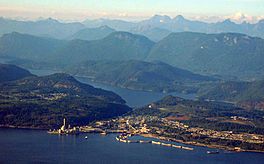Powell Lake facts for kids
Quick facts for kids Powell Lake |
|
|---|---|

Aerial view of Powell Lake and the city of Powell River
|
|
| Location | Sunshine Coast, British Columbia |
| Coordinates | 50°05′00″N 124°25′00″W / 50.08333°N 124.41667°W |
| Type | reservoir |
| Primary inflows | Powell River |
| Basin countries | Canada |
| Islands | Goat Island |
| Settlements | Powell River |
Powell Lake is a large lake located in British Columbia, Canada. It sits in the northern part of the Sunshine Coast region. The city of Powell River is right next to the lake. This city is built on a natural land barrier between the lake and the Strait of Georgia.
The lake's water flows into the ocean through the Powell River. A notable feature of the lake is Goat Island, which is a big island with mountains. Powell Lake is also important because it acts as a reservoir. It holds water for a small power station that creates electricity. This electricity helps power the city's paper mill. The lake also supplies water directly to the paper mill.
How Powell Lake Got Its Name
Powell Lake was named after a person called Israel Wood Powell. He was a government official in British Columbia. From 1872 to 1889, he worked as the Indian Commissioner for the region. This role involved working with the Indigenous peoples of British Columbia.
The Lake's Ancient Past
Scientists believe that Powell Lake was once connected to the ocean. This means it used to be an ocean inlet. Evidence for this is that some of the deepest parts of the lake still contain ancient salt water. These deep areas can be more than 500 meters (about 1,640 feet) deep.
Geologists, who study the Earth, think that the land at the mouth of Powell Lake rose up. This happened after the huge glaciers melted away at the end of the last Ice Age. This rising land created a natural barrier. It turned the ocean inlet into a freshwater lake. This change also meant that salmon could no longer swim into the lake to lay their eggs. If there were Indigenous communities living there because of the salmon, they would have been there many thousands of years ago.
Later, a dam was built at the start of the Powell River. This dam helped create more power for the local timber mill. It also made it easier to move logs from the mountains by floating them on the water. This dam further changed the lake's water levels and its connection to the river system.


